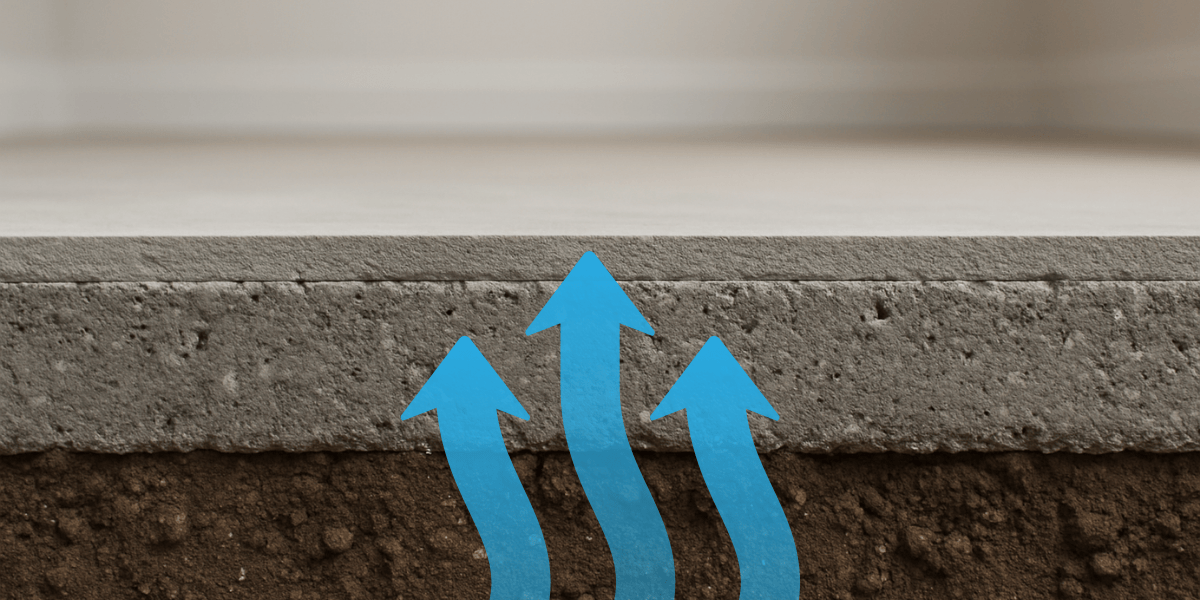Moisture is the silent saboteur of flooring. It doesn’t matter how skilled your installation is or how premium the materials are, if moisture isn’t properly understood and managed, the floor will fail. In the UK, where damp conditions are practically part of the national identity, this issue is especially critical.
For flooring contractors, the key to success lies in distinguishing between two very different types of moisture: ground bearing moisture and construction moisture. They may seem similar on the surface, but they behave differently, require different solutions, and if misdiagnosed can lead to very expensive callbacks.
Let’s break it down in a way that’s both technically sound and grounded in the day-to-day realities of UK flooring work.
Ground bearing moisture: The persistent subfloor challenge
Consider a refurbishment project in a 1950s bungalow in Kent. The client wants to replace the old carpet with engineered wood flooring. Upon inspection, you find a solid concrete slab with no visible signs of damp. However, given the age of the property, you know that a damp proof membrane (DPM) may not have been installed during the original construction.
This is a textbook case where ground bearing moisture must be considered. This form of moisture originates from the subsoil and migrates upward through the slab via capillary action and vapour diffusion. It is not a temporary condition, it is a permanent environmental factor that must be managed, not ignored!
Even if the surface appears dry, moisture can still be actively moving through the slab. Without a functioning DPM, this moisture will eventually compromise adhesives, degrade floor finishes, and potentially lead to microbial growth. The only reliable method of control is the installation of a physical or surface-applied DPM, like Bostik’s HYTEC E570 One Coat, depending on the construction details and current condition of the substrate.
Construction moisture:
Now imagine a large-scale residential development in Birmingham. The screed was laid just under a month ago, and the project manager is pushing to accelerate the programme. You conduct a relative humidity (RH) test, and the reading comes back at 85%RH. As this is a new-build property, it’s reasonable to assume that a structural damp proof membrane (DPM) has been correctly installed beneath the slab in accordance with current UK Building Regulations. This membrane is designed to prevent ground bearing moisture from migrating upward into the structure. Therefore, any elevated moisture readings in the screed are not due to rising damp, but rather the result of construction moisture, which is the residual water content left within the screed from the original mix. When screeds are laid, a significant amount of water is added to make the material workable. That water doesn’t just disappear once the surface looks dry, it needs time, ventilation, and the right environmental conditions to evaporate fully from within the slab.
Until that moisture has dissipated, the screed remains unsuitable for most floor coverings, especially impermeable ones like vinyl, LVT, or engineered wood. Proceeding with installation before the substrate has reached the required moisture threshold (typically below 75% RH for resilient flooring, or 65% for timber) risks trapping moisture beneath impermeable finishes. This can lead to adhesive failure, surface blistering, and long-term degradation of the floor system.
In such cases, you must either allow additional drying time or specify a moisture suppression system, like Bostik’s HYTEC A370 RAPID or HYTEC P510 RENORAPID, that is compatible with the chosen floor covering.
Why getting the diagnosis right is critical
Distinguishing between ground bearing moisture and construction moisture isn’t just a technical detail, it’s a decision that directly impacts the success of your flooring installation. The consequences of misdiagnosis can be costly, both in terms of materials and your professional reputation.
Take this example: if you apply a floor covering over a slab affected by ongoing ground moisture, the moisture will continue to rise unchecked, eventually breaking down the adhesive, blistering, staining, and causing the floor to fail. On the other hand, if you treat a slab with residual construction moisture as though it is a ground bearing issue, you might unnecessarily specify a full surface DPM adding cost, time, and complexity to the job without real benefit.
A precise diagnosis empowers you to:
- Select the right moisture control system whether that’s a DPM, a moisture vapour suppressant or simply more drying time.
- Justify installation delays or additional prep work with confidence and evidence.
- Safeguard your reputation by delivering a floor that performs as expected and stands the test of time.
In short, understanding the source of moisture isn’t just good practice – it’s essential to doing the job right.
Testing:
In the UK, moisture testing is governed by British Standards such as BS 8203, BS 8201, and BS 5325, which provide clear guidance on acceptable moisture levels and testing protocols.
Recommended methods:
- In-situ RH testing: Measures the internal humidity of the slab. A reading below 75% RH is generally acceptable for most resilient/textile floor coverings.
- Calcium Carbide (CM) test: A rapid, on-site method that provides a moisture content percentage by weight.
- Capacitance test: Useful for quick surface checks, but not definitive and shouldn’t be used for final moisture assessments.
As a flooring contractor your job isn’t just to fit floors, it’s to understand what’s happening underneath them too. When you can walk onto a site, carry out proper moisture testing, and clearly explain whether you’re dealing with ground bearing or construction moisture, you’re doing more than ticking a box, you’re showing real expertise.
That kind of knowledge builds trust. It helps you justify your recommendations, avoid costly call backs, and deliver floors that last, and in a trade where margins are tight and competition is high, being the one who knows what they’re taking about is what sets you apart.
Be the contractor who doesn’t just lay it and pray it, be the one who tests, protects, and sleeps at night.


